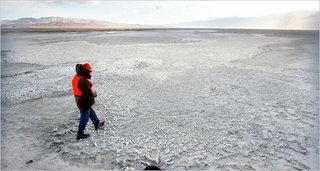A Century Later, Los Angeles Atones For Water Sins
By RANDAL C. ARCHIBOLD
Published: January 1, 2007
INDEPENDENCE, Calif. — It may fall short of a feel-good sequel to “Chinatown,” the movie based on the notorious, somewhat shady water grab by Los Angeles that allowed the city to bloom from a semi-arid desert.
Skip to next paragraph

Mike Prather, an environmental advocate, walked a dry part of Owens Lake, which emptied when the Owens River was diverted to Los Angeles.
J. Emilio Flores for The New York Times
As part of a project to restore water to the Owens Valley, a dam redirects water going to Los Angeles, causing it to flow into the Owens River.
But in one of the largest river restoration efforts in the West, water is again flowing along a 62-mile stretch of the Owens River after a dry spell of nearly a century.
That part of the river had been left mostly drained when upstream water, fed by snowmelt from the towering Sierra Nevada, was channeled 233 miles south to fill swimming pools and bathtubs throughout Los Angeles.
The restored flow is among several long-awaited steps the city is taking to help make amends for the environmental consequences of its water maneuvering, most notably the drying up of Owens Lake, an area more than three times the size of Manhattan, here in the Owens Valley.
Los Angeles agreed in December to expand efforts to control toxic dust storms that erupt from what is left of the lake, a 110-square-mile body that emptied when the river was diverted to Los Angeles through an aqueduct opened in 1913.
The lake’s salty, mineral-laced basin has been the largest single source of particulate pollution in the country. It looks so otherworldly that it doubled as a desolate planet in the movie “Star Trek V: The Final Frontier.”
To restore the river, Los Angeles built automated gates at the point where the river veers into the aqueduct. The gates steer some water into the original riverbed, setting the stage for the growth of cottonwood trees and other plants and the return of waterfowl and other animals.
Much of the water eventually returns to the aqueduct, though some of it is being used for lake irrigation and other projects.
Environmentalists here say they are keeping an eye on Los Angeles for backsliding, but they acknowledge that the new efforts will make a significant difference.
More at the link.
~~~~~~~~~
More resources:
The Owens Valley Land Grab
Images of Owens Valley
You must look at these images to see the full extent of the damage done to this region.



No comments:
Post a Comment